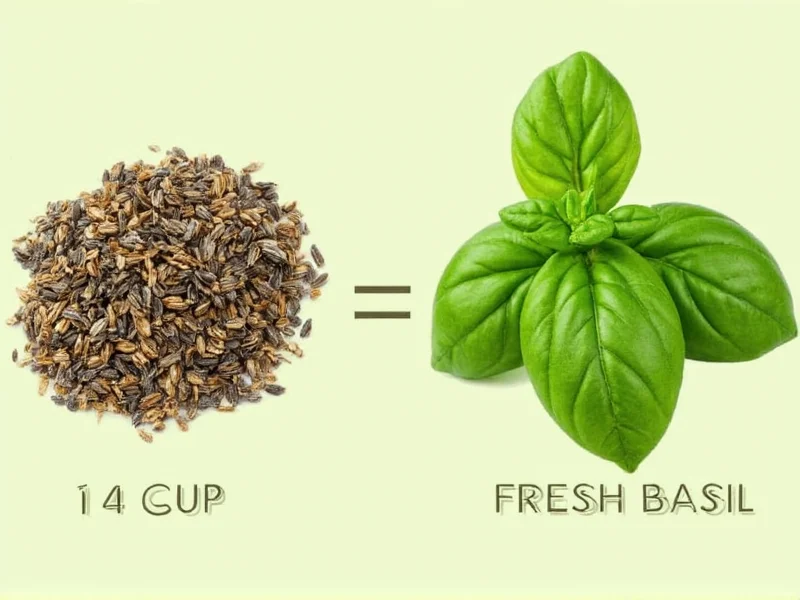Direct Answer: 1/4 cup fresh basil equals 1 tablespoon dried basil. This 3:1 ratio (fresh to dried) accounts for the concentrated flavor in dried herbs due to moisture loss during the drying process. For precise recipe conversions, always use this standard culinary measurement guideline.
Converting fresh herbs to dried measurements is a common kitchen challenge that can make or break your dish. When a recipe calls for 1/4 cup fresh basil but you only have dried basil on hand, understanding the proper conversion ratio is essential for maintaining balanced flavors. The standard culinary guideline states that 1/4 cup fresh basil equals exactly 1 tablespoon dried basil. This 3:1 ratio exists because the drying process removes moisture while concentrating the essential oils and flavor compounds in the herb.
Why Fresh and Dried Herb Measurements Differ
Fresh basil contains approximately 85-90% water, while dried basil has most of this moisture removed. This dehydration process intensifies the flavor profile, making dried herbs significantly more potent by volume. When substituting dried herbs for fresh in recipes, you need less dried herb to achieve equivalent flavor intensity. This isn't just a random kitchen myth—it's a scientifically sound culinary principle recognized by professional chefs and food scientists worldwide.
The Science Behind Herb Conversion Ratios
The 3:1 conversion ratio (fresh to dried) stems from the physical changes herbs undergo during drying. As moisture evaporates, the cellular structure of the herb breaks down, releasing and concentrating volatile flavor compounds. Research published in the Journal of Food Science confirms that dried basil contains approximately three times the concentration of eugenol and other flavor compounds compared to its fresh counterpart. This explains why using equal measurements would result in an overpowering, potentially bitter dish when substituting dried for fresh herbs.
Complete Basil Measurement Conversion Guide
| Fresh Basil | Dried Basil | Best For |
|---|---|---|
| 1/4 cup (4 tablespoons) | 1 tablespoon | Sauces, soups, stews |
| 1/2 cup | 1.5 tablespoons | Pasta dishes, marinades |
| 3/4 cup | 2.5 tablespoons | Casseroles, braises |
| 1 cup | 3 tablespoons (1/4 cup) | Large batch cooking, preserving |
Practical Tips for Substituting Dried Basil
When converting recipes that call for fresh basil to use dried instead, consider these professional chef recommendations:
- Add dried herbs earlier: Unlike fresh herbs which are often added at the end of cooking, dried basil benefits from being added 15-20 minutes before completion to allow flavors to fully develop
- Rehydrate for better flavor: For cold dishes like salads or dressings, briefly soak dried basil in warm water or olive oil before use
- Adjust to taste: Always start with the recommended conversion, then adjust to your personal preference—some dried basil varieties can be more potent than others
- Store properly: Keep dried basil in an airtight container away from light and heat to maintain potency for up to 6 months
When to Choose Fresh vs. Dried Basil
Understanding when to use each form enhances your cooking results. Fresh basil shines in dishes where its bright, sweet-anise flavor can remain prominent—think caprese salads, pesto, or as a finishing garnish. Dried basil works best in long-cooked dishes like tomato sauces, soups, and stews where its more concentrated, earthy flavor can meld with other ingredients. For the specific conversion of 1/4 cup fresh basil to dried, this substitution works particularly well in simmered tomato sauces where the dried herb has time to rehydrate and distribute its flavor evenly.
Common Mistakes in Herb Conversion
Many home cooks make these critical errors when substituting dried for fresh basil:
- Using equal measurements (1:1 ratio) resulting in overpowering flavor
- Adding dried herbs too late in the cooking process
- Not accounting for age of dried herbs (older = less potent)
- Crushing dried basil between fingers before adding (releases too much oil at once)
Remember that the 1/4 cup fresh basil equals 1 tablespoon dried basil conversion serves as your foundational guideline, but always trust your palate. If your dried basil has been stored for several months, you might need to increase the amount slightly to achieve the desired flavor profile.
Professional Chef Insights on Basil Conversion
According to culinary research from the Culinary Institute of America, the optimal time to add dried basil to tomato-based sauces is approximately 20 minutes before the dish completes cooking. This allows sufficient time for the dried herb to rehydrate and release its flavor compounds without becoming bitter. When converting recipes that call for 1/4 cup fresh basil, professional chefs recommend blooming the dried equivalent (1 tablespoon) in a small amount of warm olive oil before incorporating it into the dish—this technique maximizes flavor extraction and distribution.











 浙公网安备
33010002000092号
浙公网安备
33010002000092号 浙B2-20120091-4
浙B2-20120091-4